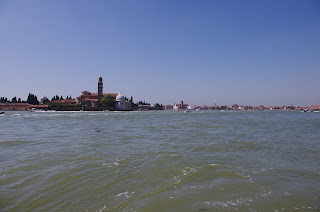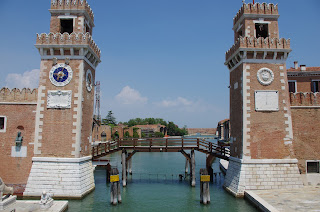It has already been a couple of weeks since our return and I think we have settled back into the groove. Time to continue the trip journal. This entry wraps up our time in Venice.
Exploring Venice requires a lot of walking. Water busses can take you quickly from one district to the other via the Grand Canal or the perimeter of the island, but to actually see the districts and explore the streets, one must walk. To cross from one side of the Grand Canal to the other, you can use one of the two main bridges, the Accademia and the Rialto, but getting to these bridges often requires navigating a labyrinth of streets. There is no straight line in Venice!
There are short cuts, however, called traghetti. The traghetto is a gondola piloted by two gondoliers which transports you from one side of the canal to the other for a mere 50 centimes.
We were in the Ca' d'Oro district across from the Rialto market and, instead of meandering back to the Rialto bridge, we decided to take the traghetto. While waiting, a French couple arrived toting their copy of the Guide Routard (a wonderful and popular travel guide among the French) so I asked if they were going to take the traghetto.
They, like us, were attempting it for the first time based on a recommendation in their Routard. And, as noted in the guide, we were all going to remain standing during the crossing as the Venetians do when taking the traghetto.
The traghetto can probably hold only six or so passengers. We were only four and once in the gondola, we shoved off into the Grand Canal.
Perhaps for speed, or perhaps for better maneuverability, traghetti have two gondoliers. Ours were all business and no small talk.
We moved out into the canal, flipped around, and begun our crossing,
giving us a great view down the Grand Canal towards the Rialto bridge.
For some reason, the old arcade game, Frogger, came to mind as we crossed to the other side. There was a lull in boat traffic making for a smooth crossing. No challenges this trip. 10 easy points!
We reached the other side in under five minutes. Less time it would take to walk down to the bridge and back up to the market.
The food market closed several hours earlier to be replaced by tables selling bric-a-brac. We found a treasure on one table, an old padlock with the original keys.
After making the tour of the market, we returned to the vendor and inquired more about the lock. She believes it's from the region north of Venice and dates to the 1800s. Regardless of provenance, we handed her 20 euros for the lock.
With lock in hand, we set out to explore some more as we headed towards a pastry shop for a late afternoon pastry and coffee. Later in the evening, we headed back to the Rialto district for a drink and snacks before dinner, popping out on a police dock for a better view of the Rialto bridge.
After a quick tourist pose on the bridge...
we found a table at a cafe overlooking the canal. We nursed our drinks and snacked on chips for almost two hours while watching the world go by.
This gondolier must be high ranking, we surmised, given his uniform, arm band, and hat. I thought the picture also captures a cross section of Venice: the local in his small boat next to the professional gondolier next to the water buss with several people trying to get a picture of the approaching Rialto bridge.
We opted for the express vaporetto that travels the larger Giudecca canal.
We'll be at the parking garage in just a few stops.
The water busses aren't filled with tourists early in the morning. Mostly locals or students going to work or school.
We were headed to Lake Como, a five hour drive from Venice, for our next three day stay.
We both agreed that Venice was our favorite city so far in Italy, and that we would have to return for a longer stay, perhaps renting an apartment, during the spring or fall seasons. We can't wait to go back.





































































